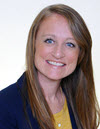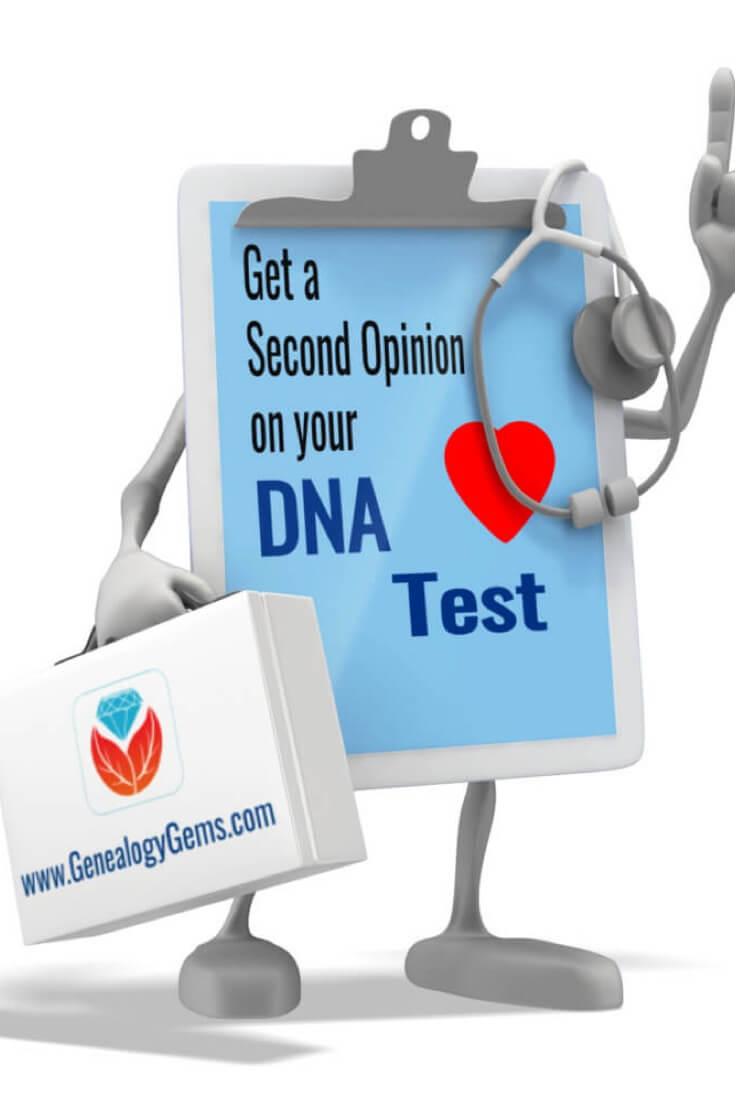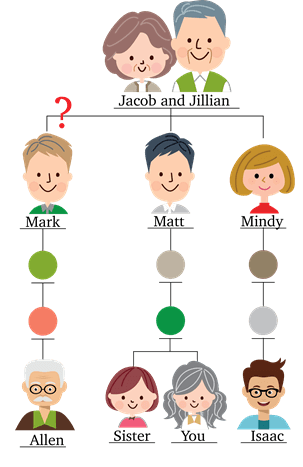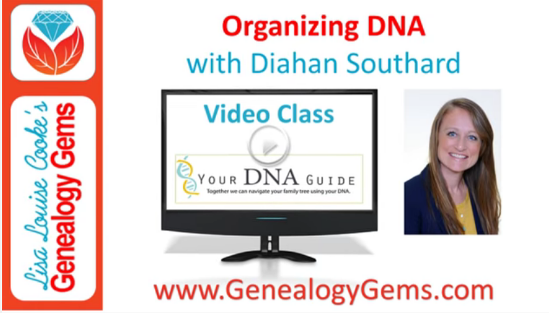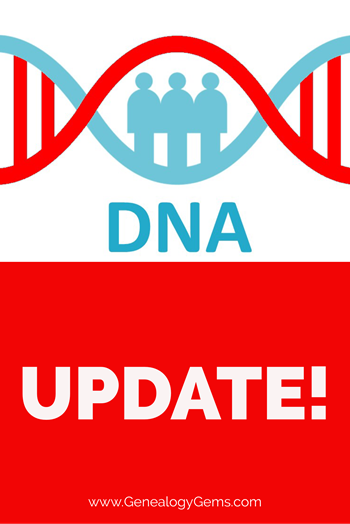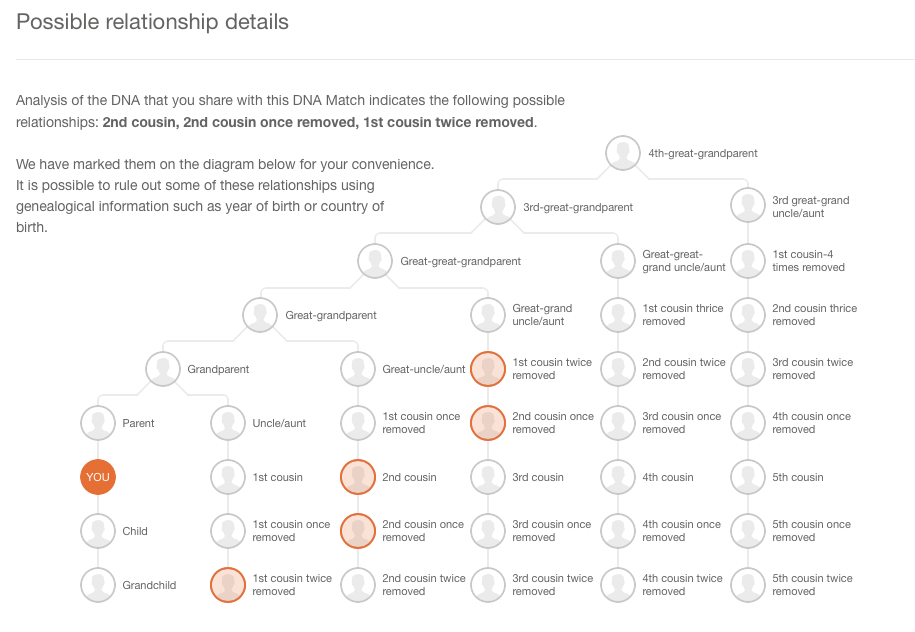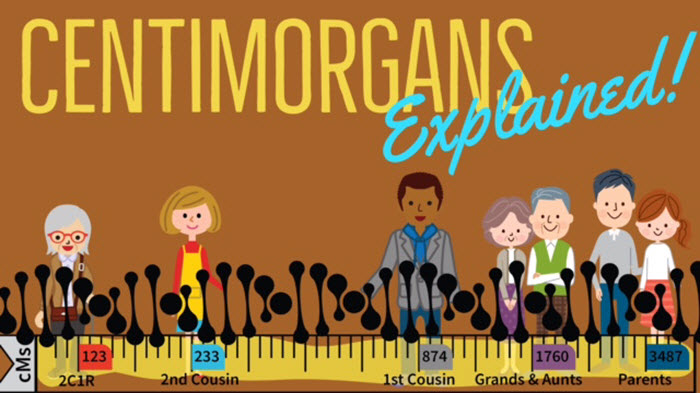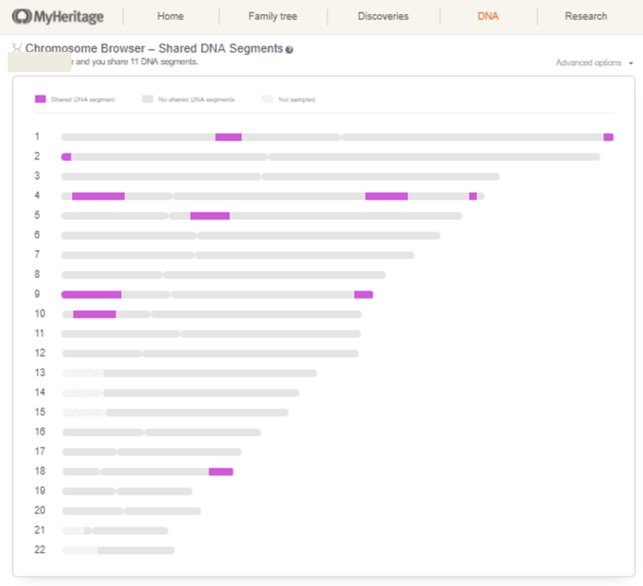by Diahan Southard | May 7, 2018 | 01 What's New, DNA |
A second opinion on your DNA test can help your genetic genealogy research in several ways. Your DNA Guide Diahan Southard proposes several scenarios that can help you look at your DNA test results in a new way. (Retesting may not even be necessary!)
Second Opinions on a DNA Test
“Get a second opinion.” That’s the advice we hear about our healthcare and the tactic my kids use when one parent says, “No.” But it should also be a strategy employed in our genetic genealogy pursuits.
Second opinions come in multiple varieties. You can move your DNA test results between companies. For example, while you can’t transfer into 23andMe or AncestryDNA, you can transfer your autosomal DNA results out of all companies and into Family Tree DNA, MyHeritage, and now Living DNA. (Click here for step-by-step instructions.) This transfer gives you a second opinion on your ethnicity results. We have talked about how those numbers can differ between companies and your “real” values may be somewhere in between.
However, you may also want to get a second opinion for your match page. Because of different analysis methods at the various testing companies, the same match might be reported to share a different amount of DNA. Those differences should be slight, and shouldn’t influence your relationship. Remember that the amount of DNA you share is measured in centimorgans (cMs), and generally speaking, the more cMs you share, the closer your relationship. (Click here to read more about centimorgans.)
That total amount of shared DNA can help us with another kind of second opinion. Because DNA inheritance is a random event, the amount of DNA two cousins receive from their shared 2X great grandparents can be very different. For example, according to data collected form the Shared cM Project (SCP) individuals who are documented third cousins vary widely in the amount of DNA they share. They may share as much as 253 cM but as little as 6 cM!
A Second Opinion Case Study
Let’s look at an example to see how a second opinion might be helpful in solving a genealogical mystery. In the image we see:
- you
- your sister
- your matches Isaac and Allen
Your match Allen believes that his ancestor Mark is actually the eldest child of Jacob and Jillian. If this is the case, Allen would be your third cousin.
However, when you look at the total amount of shared DNA, you and Allen share only 48 cMs, which is below the 74 cM average for third cousins and fits better in the range of fourth cousins. Your sister is sharing slightly more, at 54 cM. So along with Allen, you begin forming a hypothesis that his ancestor Mark is actually a nephew to Jacob and Jillian, making your common ancestor either Jacob or Jillian’s parents.
However, you then get a new match in Isaac, who is a known third cousin, also a descendant of Jacob and Jillian, and you are sharing 86 cM. You then ask Isaac to tell you how many cMs he is sharing with Allen and he reports a whopping 92 cM! If we find the average amount of shared cMs between you, your sister, and Isaac and Allen, we get 65 cMs, which is much closer to the 74 cMs we would expect if you were truly 3rd cousins. In this case we could say that the genetics supports a connection between these individuals at Jacob and Jillian.
While you could still be 4th cousins instead of 3rd, having a second opinion in your sister, and then a third opinion in your known cousin can be very helpful in determining your actual relationship to Allen. Of course, the only way to know for sure if Mark is the child of Jacob and Jillian will be to find the genealogical paper trail. But in the meantime, you can continue to look for more descendants of this couple who have been DNA tested, and get a more complete picture of your genetic relationship.
More Help with Your DNA Results
About the Author: Diahan Southard has worked with the Sorenson Molecular Genealogy Foundation, and has been in the genetic genealogy industry since it has been an industry. She holds a degree in Microbiology and her creative side helps her break the science up into delicious bite-sized pieces for you. She’s the author of a full series of DNA guides for genealogists.
Disclosure: This article contains affiliate links and Genealogy Gems will be compensated if you make a purchase after clicking on these links (at no additional cost to you). Thank you for supporting Genealogy Gems!
by Diahan Southard | Jan 20, 2018 | 01 What's New, DNA, MyHeritage |
We have a MyHeritage DNA matching update! Not only has MyHeritage DNA released a much better matching algorithm, the company that lets you upload your DNA for free has also introduced a chromosome browser. Your DNA Guide Diahan Southard shares the good news—and a quick introduction to her favorite matching tools on MyHeritage DNA.
In my first job as a grocery store clerk, I learned that most customer service issues can be solved if you listen carefully to the customer and do all you can to make it right. This is what MyHeritage has done.
For months after the launch of their in-house DNA testing product in the fall of 2016, their DNA matching algorithm had problems. Even a year later, there were concerning reports of discrepancies between the match lists of parents and children. And yet, the genetic genealogy community was patient—because MyHeritage had so far delivered on every promise they had made to the community. They had delivered a competitive origins (ethnicity) product, adopted a stringent privacy policy, and let everyone upload their DNA for free.
MyHeritage DNA matching update
Now in January of 2018, all that patience has paid off. MyHeritage has updated its matching algorithm and recalibrated all the DNA matches in their system. The result is a much more robust depiction of our relationships with others in the database. Most users are seeing a dramatic increase in the total number of matches, and a significant decrease in the number of false positives, or matches that are on your match list but shouldn’t be.
Additionally, to the delight of many genetic genealogists, MyHeritage has launched a chromosome browser. This tool allows you to see the locations on the DNA that are shared with your match. Many genetic genealogists like to use this tool to help them visualize the shared DNA, and group their DNA matches.
Now that the matching algorithm has improved, I’d like to recommend three great tools you should be using at MyHeritage to help you identify your genetic matches. Yes, one of them is the chromosome browser–but take a look at these others, too. And take note: you won’t find these exact tools at AncestryDNA.
Tool #1: List of possible relationships for your genetic matches
In a recent blog post, I described how you can narrow down your possible relationships to your genetic matches by comparing your total shared DNA to a table developed by genetic genealogy experts. MyHeritage DNA simplifies that process for you with a customized chart for each of your genetic matches. Each chart visually shows you all possible relationships, even taking into account factors like your age and gender.
To access the chart, log in to your MyHeritage account. Under the DNA tab, select “Genetic Matches.” Then click on the little question mark icon next to the relationship suggestions:
Then you’ll see a chart that’s been customized for this relationship by highlighting all your possible relationships to this genetic match:
Tool #2: Longest piece of shared DNA with your genetic matches
In addition to the range of possibilities above, you can also be misled by the total amount of DNA you share with your genetic matches. Yes, you might actually be third cousins. But if your ancestors lived in a community that intermarried a lot because they were isolated geographically or culturally, you might also just share a lot of common DNA. You might be sixth cousins three times over.
The size of the biggest piece of DNA you share with a genetic match is really important for puzzling this out. Let’s say two of your genetic matches each share 30 centimorgans of DNA with you. Both are predicted to be your fourth cousins, but one person’s longest shared piece of DNA is 18 centimorgans long, and the other’s is 9 centimorgans long. The closer match–the one you should pursue first–is the one that shares the longest piece of DNA.
At MyHeritage DNA, you can sort your list of genetic matches by longest shared segment. At the top of your list, under the “All” drop-down menu, select “Largest Segment.” You may see your match list rearrange itself (this is a clue that the total shared DNA doesn’t tell you the whole story about genetic relatedness):
Then, click on your top genetic matches to see more detail about that longest segment:
Tool #3: NEW Chromosome browser
The new chromosome browser at MyHeritage is what they’re calling an “initial release” or first draft that “will be enhanced further soon.” It’s currently embedded in each of your individual match pages. That way, you can compare what areas of genetic material you and each of your matches have in common.
“It’s a free feature that can be used by all users on MyHeritage who have taken the DNA test or uploaded DNA data,” says a company press release. “It shows the shared segments between you and a DNA Match in purple. When you hover your mouse over any shared segment you can see the genomic position of the shared segment, the size of the segment, and the number of SNPs there. Grey segments are not shared with the DNA Match and crisscrossed sections were not analyzed due to the lack of SNPs in those regions.”
I’ll be back soon with more tips and tutorials on getting the most out of the new MyHeritage chromosome browser. I just wanted to alert you that it’s there—one more valuable tool in the MyHeritage DNA matching toolbox.
Advanced DNA tools for family history research
If you’re ready to get more genealogy information out of your DNA testing experience, consider whether Diahan’s Advanced DNA Bundle might be a good investment for you. These laminated guides are available singly (click on individual titles below) or as a value-priced bundle and can help you with very specific “next steps:”
- Gedmatch: A Next Step for Your Autosomal DNA Test. Gedmatch is a third‐party tool for use by genetic genealogists seeking to advance their knowledge of their autosomal DNA test. This guide navigates you through the myriad of options and point out only the best tools for your genetic genealogy research.
- Organizing Your DNA Matches. With millions of people now in the possession of a DNA test–and most with match lists in the thousands–many are wondering how to keep track of all this data and apply it to their family history. This guide provides the foundation for managing DNA matches and correspondence, and for working with forms, spreadsheets, and 3rd party tools.
- Next Steps: Working With Your Autosomal DNA Matches. This guide outlines what to do next to maximize the power of DNA testing in genealogy. With this guide in hand, genealogists will be prepared to take their DNA testing experience to the next level and make new discoveries about their ancestors and heritage.
Disclosure: This article contains affiliate links and Genealogy Gems will be compensated if you make a purchase after clicking on these links (at no additional cost to you). Thank you for supporting Genealogy Gems!
Your DNA Guide
Diahan Southard is Your DNA Guide here at Genealogy Gems! She has worked with the Sorenson Molecular Genealogy Foundation, and has been in the genetic genealogy industry since it has been an industry. She holds a degree in Microbiology and her creative side helps her break the science up into delicious bite-sized pieces for you. She’s the author of our DNA guides Getting Started: Genetics for Genealogists, and Y Chromosome DNA for Genealogists (click STORE in the menu above)
by Lisa Cooke | Jan 16, 2017 | 01 What's New, DNA
Organize DNA matches with this innovative approach. If you are feeling overwhelmed with your DNA results, you are not alone. Learning to organize your DNA matches in an effective way will not only keep your head from spinning, but will help you hone in on possible matches that will break down brick walls. Here’s the scoop from Your DNA Guide, Diahan Southard.

I can tell whose turn it was to unload the dishwasher by the state of the silverware drawer. If either of the boys have done it (ages 13 and 11,) the forks are haphazardly in a jumble, the spoon stack has overflowed into the knife section, and the measuring spoons are nowhere to be found. If, on the other hand, it was my daughter (age 8,) everything is perfectly in order. Not only are all the forks where they belong, but the small forks and the large forks have been separated into their own piles and the measuring spoons are nestled neatly in size order.
Organize Your Imaginary DNA Drawer
Regardless of the state of your own silverware drawer, it is clear that most of us need some sort of direction to effective organize DNA matches. It entails more than just lining them up into nice categories like Mom’s side vs. Dad’s side, or known connections vs. unknown connections. To organize DNA matches, you really need to make a plan for their use. Good organization for your test results can help you reveal or refine your genealogical goals and help determine your next steps.
Step 1: Download your raw data. The very first step is to download your raw data from your testing company and store it somewhere on your own computer. See these instructions on my website if you need help.
Step 2: Identify and organize DNA matches. Now, we can get to the match list. One common situation for those of you who have several generations of ancestors in the United States, is that you may have ancestors that seem to have produced a lot of descendants. These descendants may have caught the DNA testing vision and this can be like your overflowing spoon stack! All these matches may be obscuring some valuable matches. Identifying and putting those known matches in their proper context can help you identify the valuable matches that may lead to clues about the descendant lines of your known ancestral couple.
In my Organizing Your DNA Matches quick sheet, I outline a process for identifying and drawing out the genetic and genealogical relationships of these known connections. Then, it is easier to verify your genetic connection is aligned with your genealogy paper trail and spot areas that might need more research.
This same idea of plotting the relationships of your matches to each other can also be employed as you are looking to break down brick walls in your family tree, or even in cases of adoption. The key to identifying unknowns is determining the relationships of your matches to each other.
Step 3: See the relationship between genetics, surnames, and locations. Another helpful tool is a trick I learned from our very own Lisa Louise Cooke–that is Google Earth. Have you ever tried to use Google Earth to help you in your genetic genealogy? Remember, the common ancestor between you and your match has three things that connect you to them: their genetics, surnames, and locations. We know the genetics is working because they show up on your match list. But often times you cannot see a shared surname among your matches. By plotting their locations in the free Google Earth, kind of like separating the big forks from the little forks, you might be able to recognize a shared location that would identify which line you should investigate for a shared connection.
So, what are you waiting for? Line up those spoons and separate the big forks from the little forks! Your organizing efforts may just reveal a family of measuring spoons, all lined up and waiting to be added to your family history.
More on Working with DNA Matches
How to Get Started with Using DNA for Family History
Confused by Your AncestryDNA Matches? Read This Post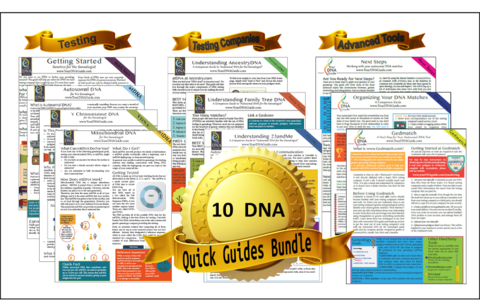
New AncestryDNA Common Matches Tool: Love It!
by Lisa Cooke | Jan 9, 2017 | 01 What's New, DNA |
As genealogists, we spend our time trying to ferret out the real story in our family’s oral history, or at least from the records they left behind. Record research is critical, but now we have an amazing new tool…DNA matching.

Genealogists constantly check family stories against the information on records, searching for what sounds plausible and what doesn’t. Even when we have total agreement in our records, more information often comes along…like DNA testing. In fact, DNA matching may shed light on even more apparent discrepancies.
Family Lore vs. DNA Findings
I recently read an article in the Wall Street Journal about a reporter, Cameron McWhirter, who shared finding that kind of discrepancy between his family lore and his DNA. He even goes so far as to say, “I am descended, at least partially, from liars.” He makes the point, “many immigrants reinvented themselves when they arrived here (the United States).” This could be a nice way of saying they had a chance to invent a new legacy, not just re-invent it. His assessments were certainly interesting and worth reviewing. It helps us see how DNA testing can affect the way we look at our family stories and traditional research results.
McWhirter may be like some folks today who have never set foot inside a courthouse or scanned through microfilm, but instead relies heavily on internet research. Some of these modern genealogists never gave their family history a second thought until, like McWhirter, the death of parents started to inspire them to dig deeper. Due to the large volume of information online, the budding genealogist is “quickly pulled into the obsessive world of modern genealogical research.”

Example of an ethnicity report from Ancestry.com.
McWhirter’s personal story was that while his dad was proudly and solidly a self-proclaimed Scot, the records and DNA matching revealed his heritage was actually from Ireland and eastern Europe. McWhirter says that his “father hated Notre Dame, but judging by my results he could have been one-quarter to one-half Irish. He spoke dismissively of people from Eastern Europe, but part of his genetic code likely came from that region.”
McWhirter’s evaluation of his genetic report includes only his ethnicity results, which as you can hear, were meaningful to him in the way that flew in the face of his father’s prejudices and assertions of his own identity.
However, the ethnicity results fall short of the point of testing for most genealogists.
He has the opportunity to more powerfully transform his sense of family identity by taking a look at his match list. Here, he may see an actual living cousin who was also descended from his German great-grandmother, who maybe never mentioned that she was also Jewish.
The Real Goal: DNA Connections to Living Family
Connecting with other cousins who also have paper trails to our ancestors serves to provide further confidence that we have put all the pieces together and honored the right ancestor with a spot on our pedigree chart. We multiply our own research efforts by finding more people like us—literally—who are descended from the same people. As long as they are as diligent in their research as we are, we can make these connections that could finally bust through those genealogy brick walls and more.
At a recent conference, I met a fifth-cousin. Even with a connection that distant, it was exciting and it encouraged us to want to look again at our connecting ancestors. To me, that is the bigger picture and the real goal—when the paper trail comes together with the DNA results and turns into real live cousins.
The Next Step: Using Your DNA Results to Find Living Family
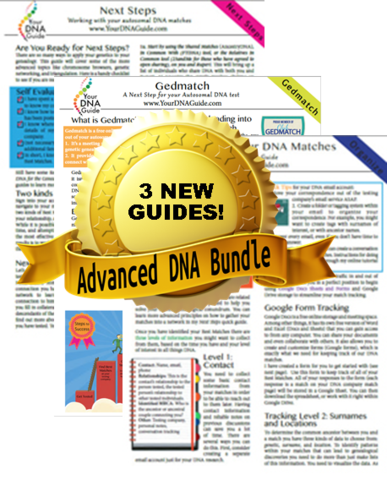 Maybe you are like Cameron McWhirter: you’ve taken a DNA test, been intrigued or disappointed by the ethnicity results, but haven’t fully explored your matches on your list. You may be seriously missing some opportunities! If that is you, I have written my new DNA quick guide just for you. It’s called “Next Steps: Working with Your Autosomal DNA Matches.” This guide will teach you how to leverage the power of known relatives who have been tested. You will get an intro to chromosome browsers and their role in the search process and access to a free bonus template for evaluating genealogical relationship of a match to the predicted genetic relationship. This guide also gives you a methodology for converting unknown relatives on your match list into known relatives.
Maybe you are like Cameron McWhirter: you’ve taken a DNA test, been intrigued or disappointed by the ethnicity results, but haven’t fully explored your matches on your list. You may be seriously missing some opportunities! If that is you, I have written my new DNA quick guide just for you. It’s called “Next Steps: Working with Your Autosomal DNA Matches.” This guide will teach you how to leverage the power of known relatives who have been tested. You will get an intro to chromosome browsers and their role in the search process and access to a free bonus template for evaluating genealogical relationship of a match to the predicted genetic relationship. This guide also gives you a methodology for converting unknown relatives on your match list into known relatives.
So check it out, either by itself or as part of my Advanced DNA bundle, which comes along with my new Gedmatch guide and a guide expressly for organizing your DNA matches.
